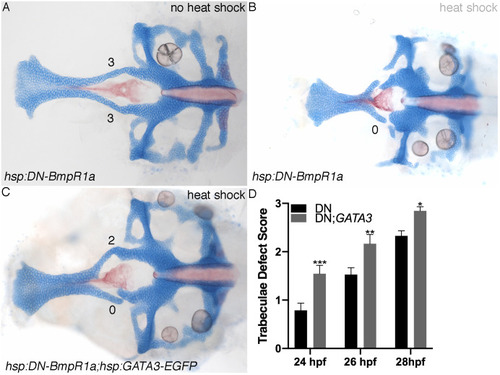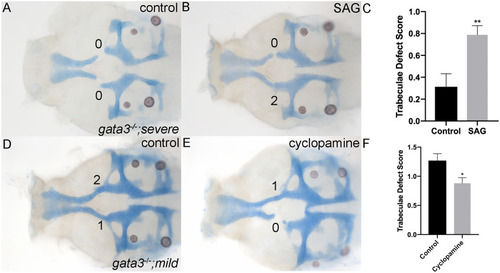- Title
-
Variation in phenotypes from a Bmp-Gata3 genetic pathway is modulated by Shh signaling
- Authors
- Swartz, M.E., Lovely, C.B., Eberhart, J.K.
- Source
- Full text @ PLoS Genet.
|
(A) As previously reported |
|
(A-G) Flat mounts of 4 dpf neurocrania, anterior to the left showing magnified images of trabeculae. Phenotypes were scored on individual sides of the neurocranium according to the level of disruption to the trabeculae. (A) Wild type phenotype (score = 3) with trabeculae fused and in one plane with the posterior neurocranium. The cells within the trabeculae are arranged into a column resembling a stack of coins. (B) Disruption to the columnar arrangement of trabeculae cells (score = 2) with proper fusion to the posterior neurocranium with all cells in one plane. (C) Trabeculae cells not stacked properly and fused inappropriately, below the plane of the posterior neurocranium, see arrowhead (score = 1). (D) Loss of trabeculae cells (score = 0) and therefore no fusion to the posterior neurocranium. (E-G) 4 dpf flat mounted neurocrania, anterior to the left showing examples of trabeculae scoring. (E) Wild type zebrafish with arrowhead indicating proper lateral commissure fusion. (F-G) gata3 mutant embryos, arrowhead in G indicating improper lateral commissure fusion. In subsequent figures the numbering above the trabeculae reflect trabeculae scoring. PHENOTYPE:
|
|
(A-D) Lateral views, anterior to the left, of EXPRESSION / LABELING:
|
|
(A) Embryo carrying the PHENOTYPE:
|
|
(A-C) Wild type |
|
(A-D) Lateral views with anterior to the left of 36 hpf |
|
(A-C) Flat mounts of 4 dpf neurocrania anterior to the left. (A) Wild type phenotype of the PHENOTYPE:
|
|
(A-B) Flat mounts of 5dpf PHENOTYPE:
|
|
(A-D) Flat mounts of 5dpf gata3 b1075/b1075 neurocrania anterior to the left. (A-B) control untreated-embryos from the gata3 “severe” background showing normal stacking and fusion of trabeculae. Both of (A) wild type and (B) heterozygotes develop normally. (C-D) Cyclopamine-treated embryos. (C) Wild type embryo showing normal stacking and fusion of trabeculae (n = 22/22). (D) Heterozygote embryo displaying complete loss of trabeculae with severe clefts (n = 6/61). PHENOTYPE:
|
|
(A) Lateral view of 36 hpf embryo, blue box indicates region of interest in the maxillary trabeculae precursors. (B) Confocal z slice of region of interest in (A). Red dots are labeled ptch2 transcripts. (C) Quantification for each group. Mild mutants have significantly elevated levels of ptch2 relative to the severe mutants (p = 0.0085) and the mild wild types (p = 0.0183). Mild wild type x = 13.11, S.E. = 1.506, n = 18; mild mutant x = 20.87, S.E. = 2.360, n = 15; severe wild type x = 14.40, S.E. = 1.904, n = 15; severe mutant x = 11.50, S.E. = 1.640, n = 12. |










